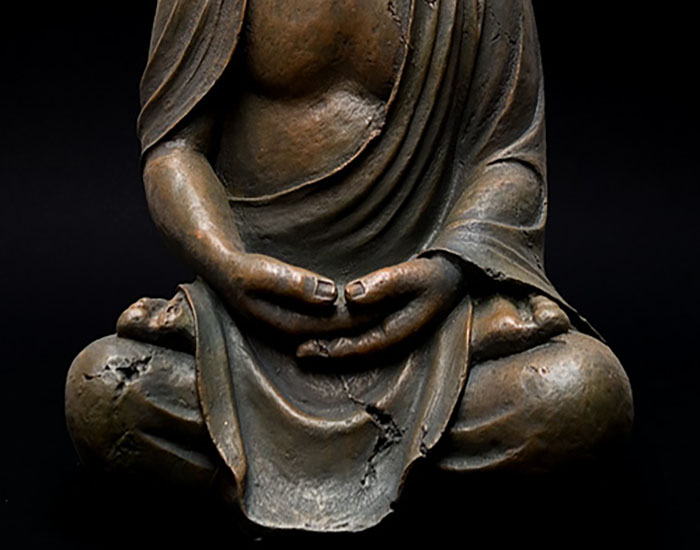
Referring to the prince Siddhartha meditating under the pipal tree before he achieved enlightenment, the dhyana mudra is one of the five common mudras in Buddhist art. Dhyana, meaning “meditation” in Sanskrit, denotes a state of concentration and is most commonly associated with the fourth Dhyani-Buddha Amitabha. Also known as yoga mudra, it is thought to have developed as an iconographic element in Gandhara, although the gesture was prevalent in yogic practices much earlier.
The dhyana mudra is performed in the seated padmasana position and is usually depicted using both hands, with the hands held at the level of the stomach and resting on the thigh or lap; the right hand, with all fingers fully extended is placed palm-up over the similarly placed left hand. The orientation of the thumbs differ in different traditions. In India, the thumbs are parallel to the other fingers and each other, while in the Wei Bhuddist tradition of China, they are angled outwards slightly to form a triangle, which symbolises the triratna, or the Three Jewels of Buddhism. The overlapping arrangement is meant to suggest that method or means (denoted by the right hand) can only arise out of the wisdom of meditation (denoted by the left hand). Some traditions also interpret the hand placed on top as signifying realisation or enlightenment and the hand underneath as the world of appearances, suggesting that meditation is a means to achieve the former by transcending over the latter.
In certain instances, the mudra is made using the left hand, which is placed on the lap, with the palm facing upward and represents the principle of wisdom or meditative void. Occasionally ritualistic objects such as a text or a bowl of alms may be placed on the upturned hand — for instance, in certain representations of Bhaisajyaguru, or the “Medicine Buddha,” who has a medicine bowl in his hands.
Popular in Theravada Buddhism, it is also depicted and practiced in a variant form known as samadhi mudra, in which the index fingers and thumb of the overlapping hands are raised to meet each other.
First Published: April 21, 2022
Last Updated: July 26, 2023


